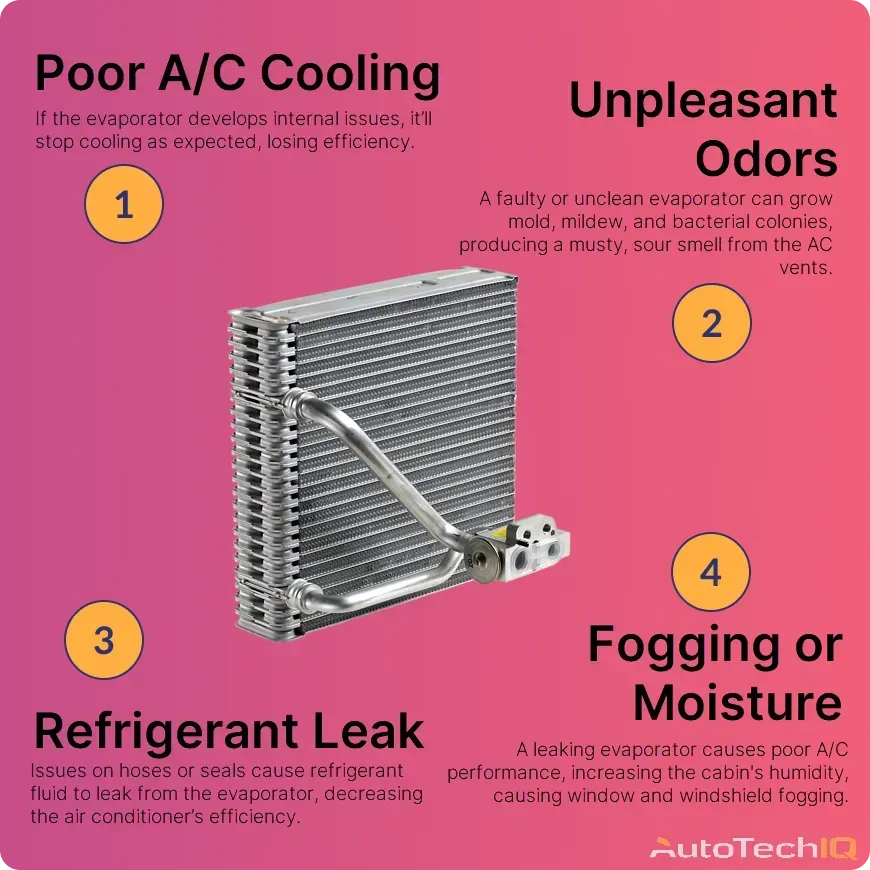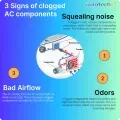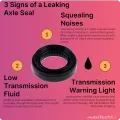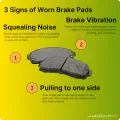
The AC evaporator is part of a car's air conditioning system. It's a coil-like component behind the dashboard that uses a refrigerant liquid to stay very cold. Then, the AC draws the warm air inside the cabin and throws it on this coil. Next, the air becomes cold through the coil and is blown back inside the cabin. This process absorbs heat from the air inside the cabin and releases it outside, only returning cold air inside.
How much does it cost to replace an evaporator?
An AC evaporator replacement cost depends on the make and model of your vehicle, labor rates, and whether the part is pristine or aftermarket. Luxury or high-end vehicles are generally in a further price range. It's also important to note that accessing the evaporator usually requires dismantling the dashboard, contributing to the labor cost. Always consult with a local mechanic or dealership for a precise estimate.
How long do car evaporators last?
Car AC evaporators often last the vehicle's lifetime. They can last 10 to 15 years; usage, maintenance, and driving conditions can affect this range. However, exposure to road salts, humid climates, or bad AC maintenance can reduce its lifespan. Still, many drivers may never need to replace the evaporator during their time with a vehicle.
How do I know if I need a new evaporator?
You might need a new evaporator if your car is showing these specific signs and symptoms:
-
Reduced cooling: The evaporator might be the issue if the air isn't as cold as it used to be.
-
Unpleasant odors: A musty or moldy smell can indicate mold/mildew buildup on the evaporator.
-
Persistent fogging on windows: This could mean the evaporator is leaking refrigerant, causing increased humidity.
-
Frequent AC compressor cycling: If the compressor turns on and off frequently, it might be due to an evaporator leak causing low refrigerant levels.
-
Visible leaks: Spotting refrigerant inside the cabin or under the dashboard is a clear indicator.

How do you clean an AC evaporator in a car treatment?
Cleaning the AC evaporator makes it cool better and removes any weird smells. Here's how it's done:
-
Access the Evaporator: Often behind the dashboard, access might require removing some panels or parts of the dashboard.

-
Turn Off the Car: Ensure the vehicle is off and the keys are removed.
-
Evaporator Cleaner: Purchase an AC evaporator cleaner for cars. These are typically aerosol sprays designed for this purpose.
-
Spray the Cleaner: Spray the cleaner directly onto the evaporator coils following the product's instructions. A foam will break down and dissolve the dirt, debris, and microbial buildup.
-
Let it Sit: Allow the cleaner to sit and work for the specified time, usually 10-15 minutes.
-
Rinse (If Required): Some cleaners require rinsing, while others are "no-rinse" formulas. Use clean water and a spray bottle to rinse, but watch out not to spray other components.
-
Dry: Let the evaporator (coil-like part) dry completely. Turning the fan on without the AC can speed this up.
-
Replace Cabin Filter: It's good to replace the cabin air filter after cleaning the evaporator to have a completely clean system.
-
Reassemble: Once everything is dry, put all the parts and panels back on.
-
Test: Start the vehicle and turn on the AC to check if it's working correctly.
If you're uncomfortable accessing the evaporator, consider seeking assistance from a professional mechanic.
What makes an evaporator coil go bad?
Evaporator coils can deteriorate or malfunction due to several reasons:
-
Corrosion: Over time, moisture mixed with air pollutants can cause the coils to corrode, especially if they're frequently exposed to substances like road salt in certain climates.
-
Physical Damage: Road debris or accidents can physically damage the evaporator, depending on its location.
-
Refrigerant Leaks: A leak in the system can cause the refrigerant to escape, leading to a loss of cooling efficiency. The leak might be because of corrosion, cracked seals, loose connections, etc.
-
Clogging: Dust, debris, and microbial growth on the evaporator can block airflow. This buildup might cause the evaporator to freeze since cold air gets stuck inside, potentially leading to cracks.
-
Vibrations: Constant vibrations can cause wear and tear or break the AC evaporator's connections.
-
Poor Maintenance: Lack of regular maintenance, like cleaning and checking the AC system, affects the evaporator coil.
-
Manufacturing Defects: Though less common, manufacturing flaws can make the evaporator faulty.
What happens when the AC evaporator goes bad?
When the AC evaporator malfunctions or goes bad, several noticeable symptoms and effects can occur:
-
Reduced Cooling: The primary function of the evaporator is to absorb heat from the car's interior. If it's not working correctly, the air blowing from the vents may not be as cold or might not be cold at all.
-
Unpleasant Odors: Mold, mildew, or bacterial buildup on a failing evaporator can produce a musty or sour smell when the AC is turned on.
-
Fogging or Moisture: A leaking evaporator can cause increased humidity inside the cabin, leading to persistent fogging inside windows and windshield.
-
Refrigerant Leak: The evaporator may leak refrigerant into the cabin, which can be seen as an oily residue or produce a sweet, chemical smell.
-
AC Compressor Issues: The compressor might cycle on and off frequently if the system detects low refrigerant levels due to a leak in the evaporator.
-
Frozen Coil: Reduced airflow, either from a clogged evaporator or other issues, can lead to the coil freezing, which further reduces the AC's efficiency.

-
Increased Fuel Consumption: If the AC system continuously tries to compensate for the reduced efficiency, it may cause a slight increase in fuel consumption.
Note that a faulty evaporator can damage other AC system components.
How do you test a car's AC evaporator?
Testing a car AC evaporator helps to find leaks or blockages. Here's a step-by-step process:
-
Visual Inspection
-
Start by looking for any obvious damage or leaks around the evaporator area, behind and around the dashboard.
-
Sniff Test
-
Turn on the AC. A bad evaporator can release a chemical or sweet smell due to refrigerant leakage.
-
UV Dye Test
-
Introduce a UV-reactive dye into the AC system.
-
Run the AC for a while to circulate the dye throughout the system.
-
Use a UV light around the evaporator area (on the cabin air vents or under the dashboard) for any signs of the dye, which would indicate a leak.
-
Use a UV borescope to remotely access the evaporator core through the drain hole.
-
Pressure Test
-
Attach a set of AC gauges to the service ports; they'll measure the pressure.
-
Turn on the AC and observe the pressures. Low pressure on the low side or high pressure on the high side indicates a problem.
-
Turn off the car and monitor the gauges. A significant drop in pressure over a short time indicates a leak.
-
Soap Bubble Test
-
While the system has pressure, apply soap to areas you believe are leaking. Bubbles forming indicate a leak.
-
Electronic Leak Detector
-
The leak detector is a portable device that detects refrigerant gasses. Pass it around the evaporator area and cabin vents. An alarm or light indicates a leak.
-
Temperature Check
-
Using an infrared thermometer, measure the temperature of the air coming out of the vents. The evaporator is likely faulty if the temperature isn't cold enough (given the current refrigerant pressure and outside temperature).
Remember, working with an AC system needs caution, as the refrigerant is under high pressure and can be harmful.
What are the most common things a driver would notice when the evaporator core needs service?
Reduced Cooling Efficiency:
When the evaporator core is malfunctioning, it can't absorb heat effectively. This leads to the AC blowing warmer air, making the cabin hot.
Unpleasant Odors:
A failing evaporator can lead to microbial growth like mold and mildew. Then, it can blow air with a musty or sour smell, indicating contamination.
Fogging on Windows:
If the evaporator leaks refrigerant, it increases humidity inside the cabin. This results in fog or mist on windows and windshields.
Frequent AC Compressor Cycling:
The compressor may turn on and off due to a leak in the evaporator. This problem is easy to notice by the cycling sounds.
Presence of Refrigerant Inside the Cabin:
A significant leak in the evaporator can allow refrigerant into the cabin. This issue can result in oily residue around vents or a distinct chemical or sweet smell.
How does the shop typically educate car owners about evaporator core replacement service using inspection images?
Have you ever wondered what a top-tier, trustful vehicle service looks like? We know how it is, and we'll share it with you through a fictional customer-technician interaction. The story, although fictional, is based on actual services and is about a faulty evaporator core.
Jane noticed her car's AC released a musty smell and wasn't cooling correctly. She decided to visit her local repair shop for a consultation.
Inspect: Upon arrival, technician Mike greeted her and began the inspection by looking at the AC system externally, paying attention to the evaporator core area.
Test: Mike used an electronic leak detector around the dashboard and vents to check for leaks. The device beeped, indicating a problem around the evaporator area.
Evaluate: After the initial tests, Mike removed dashboard panels to access the evaporator core. Then, he took several pictures of the component, capturing areas of corrosion, discoloration, damage, and potential leaks.
Diagnose: Mike invited Jane to see his images of the evaporator core. He zoomed in on the wear signs, pointing out the visible corrosion and the areas with leaks. He explained, "These visual signs often indicate a failing evaporator core." By seeing these images, Jane could understand the root cause of her car's AC issues.
Confirm Repair is Completed: Mike proceeded with the repair after receiving Jane's approval. Once done, he took images of the new evaporator core. Jane saw these photos in a "before and after" comparison, confirming the service's completion and effectiveness.
Using real-time images of the wear and the repair process, Mike explained to Jane about the evaporator core replacement; he went through its benefits and how it fixes her complaints. This process creates trust and transparency with the client.
What are the top 5 root causes creating symptoms in a malfunctioning AC evaporator?
Refrigerant Leak
The evaporator may develop small holes or cracks, leading to refrigerant escape. This results in reduced cooling efficiency and possible refrigerant odor inside the cabin.
Corrosion
Over time, moisture and pollutants can cause the evaporator to corrode. Corroded areas can hinder heat absorption and potentially lead to leaks.
Clogging
Accumulation of dust, debris, or microbial growth can block airflow over the evaporator. This diminishes cooling efficiency and may produce a musty odor.

Physical Damage
Impacts or vibrations can damage the evaporator or its connections. Such damage can reduce its effectiveness and possibly lead to leaks.
Manufacturing Defects
On rare occasions, the evaporator may have inherent flaws from production. Such defects can result in premature failure or reduced performance.
What are the top 5 fixes for a malfunctioning AC evaporator?
Evaporator Replacement
If severely damaged or corroded, the best solution is to replace the entire evaporator unit, ensuring optimal cooling and system integrity.
Refrigerant Recharge
Post-leak repair, the system is refilled with the correct amount of refrigerant, restoring the AC's cooling efficiency.

Clean the Evaporator
Removing debris or microbial growth restores airflow and eliminates bad odors, ensuring better cooling.
Seal Small Leaks
Minor leaks can sometimes be sealed using specialized AC sealants, providing a temporary or long-term fix.
Replace O-rings and Seals
Over time, seals and O-rings can deteriorate. Replacing them prevents refrigerant leaks and ensures a tight, efficient system.

Summary
A car's AC evaporator is crucial for the air conditioning to work. The main problems that affect this component are refrigerant leaks, corrosion, clogging, physical damage, and manufacturing defects. In most cases, replacing the evaporator, recharging the refrigerant, cleaning the unit, sealing minor leaks, and replacing worn-out seals or O-rings fix the issue. Understanding the problem and how it begins helps car owners address AC issues promptly, ensuring a comfortable and safe driving experience.
There's an auto shop near you delivering fair, transparent service like you've read here.
Feel free to visit our 'Shop Near You' page and search for our certified repair shops in your area. These businesses provide top-notch services and expert inspections using advanced diagnostic tools. You'll witness the same level of care and attention to detail that we've highlighted in this article. These shops share our goal of ensuring your vehicle receives the best possible maintenance. At this goal's core, your knowledge of what's happening to your car and how to maintain it is our #1 priority.
Other news
-
Car is Squealing When Driving

-
What is Preventative Maintenance and What Are The Benefits of it?

-
JobViewIQ - DVI Process Training - Part of the Auto Care Alliance Benefits

-
7 Signs of Clogged AC Components

-
How Much Does a Transmission Fluid Change Cost?

-
7 Signs of a Leaking Axle Seal

-
8 Signs of a Bad Brake Pad
